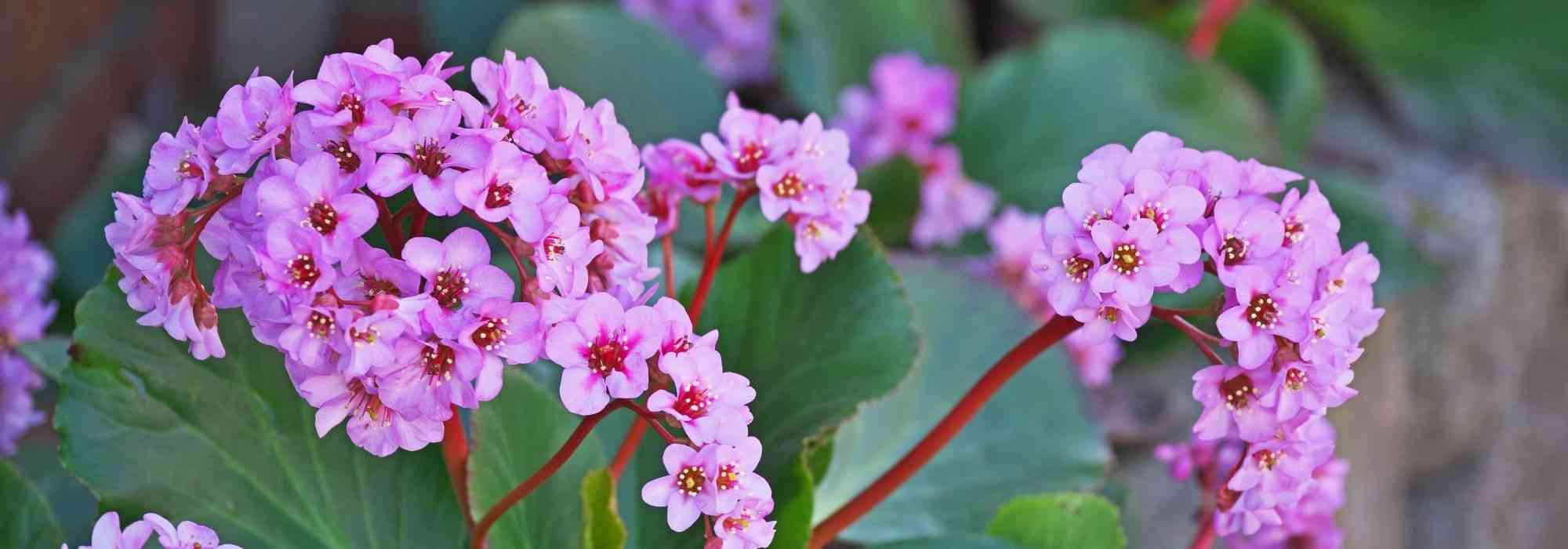
How to choose a bergenia?
Buying guide and criteria to find the ideal variety
Contents
Bergenias, also known as shoe plants, come in many varieties. The flowers can be pink, white, or red and bloom from late winter to late spring.
As for the foliage, while all bergenias are evergreen, remaining decorative throughout the year, some varieties have large, impressive leaves or even take on vibrant colours in winter.
Finally, there are compact varieties ideal for pot cultivation, while others, which are more imposing, are better suited for growing in the ground.
Based on various criteria of colour, size, and uses, we will help you choose the right bergenia to find the perfect variety for your garden, terrace, or balcony.
Choosing a bergenia based on flower colour
Bergenias may not offer as great a diversity of colours as other flowers, but they provide subtle shades in pink, red, or white that can fit into any garden style. From terraces to pathway borders, balconies to woodland areas, and window sills to cool rockeries, the colours of bergenias will find their place in many situations.
Choose from very delicate pale colours or darker hues that bring a true touch of vibrancy.
Pink Bergenias
This is the most well-known colour among bergenias: pink! The flowers can present several shades, ranging from a soft pastel pink to a bright, vivid pink that certainly catches the eye.
‘Dragonfly Angel Kiss’ or ‘Baby Doll’ showcase a delicate pale or light pink, for example.
For a bright and sparkling pink, opt for the typical species of Bergenia cordifolia or ‘Bartok’. The Bergenia purpurascens offers flowers of a rather fresh pink, rising atop striking red-purple stems.
For a darker colour, try ‘Wintermarchen’. ‘Eroïca’ features intense fuchsia pink flowers with purplish hues, while ‘Ouvertüre’ leans more towards a magenta pink.
And for a beautiful gradient blending light pink and bright pink, look to the lovely varieties ‘Rosenkristall’ or ‘Pink Dragonfly’.
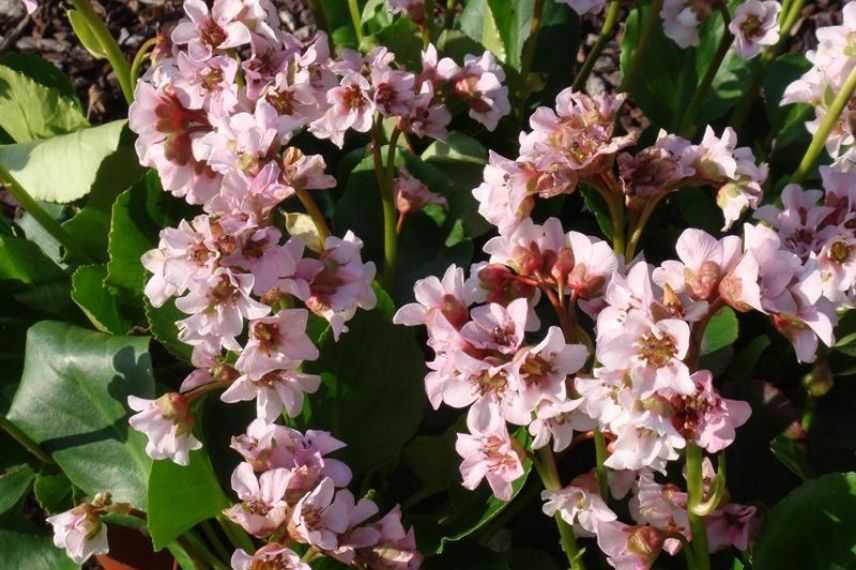
Bergenia hybrid ‘Harzkristall’ (photo Guido)
White Bergenias
White bergenias bring a refined and delicate touch. Very easy to pair, they also allow other colours of plants to stand out and add lightness to a pot. The white is sometimes subtly enhanced by another shade, green, pink, or purple.
‘Ice Queen’ produces quite astonishing green and cream bells, just like ‘Jelle’, whose white petals are accented by a pale green centre.
‘Bressingham White’ is certainly one of the most immaculate varieties, with its pure white flowers simply surrounded by sepals (supporting the flower corolla) of a pinkish green.
On its part, ‘Harzkristall’ graces us with a very lovely pinkish white, with a red-purple centre.
Finally, ‘Bach’ produces white-pink bells, with a dark cherry-black centre creating a beautiful contrast.
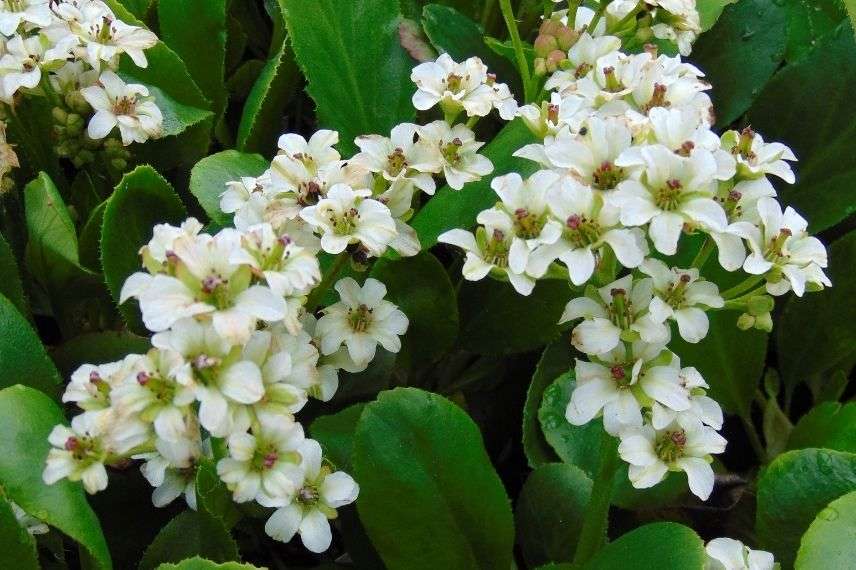
Bergenia ‘Bressingham White’
Red Bergenias
Less common, but perfect for adding a dynamic touch to the garden or terrace, red bergenias will make a statement at the end of winter. While they may not display the intense, deep red of a tulip, their colour is equally charming and will oscillate between a dark pink and purplish hues.
Among them, we can mention the bergenia ‘Abendglut’ with flowers tinged with red-purple, or ‘Winterglut’ with its intense magenta flowering.
‘Bressingham Ruby’ offers a flowering so dark pink that it appears red.
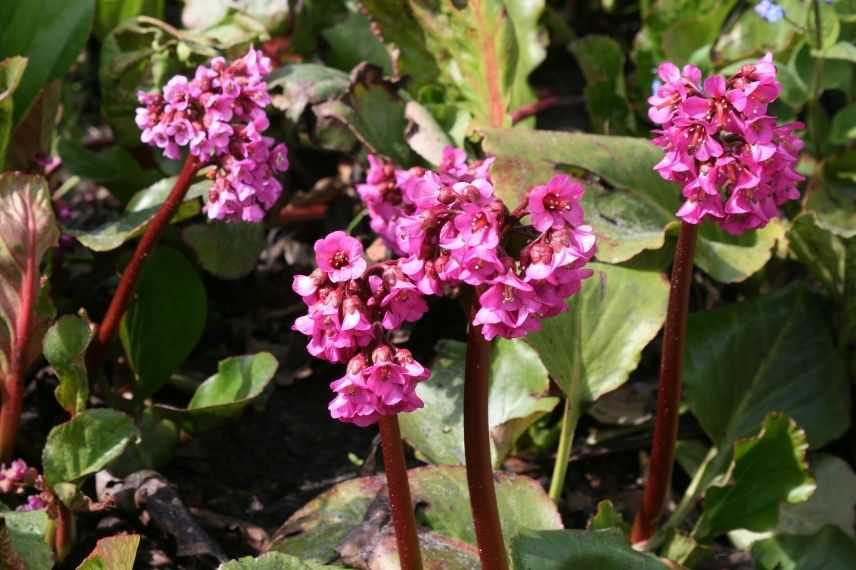 Bergenia hybrid ‘Abendglut'[/caption>
Bergenia hybrid ‘Abendglut'[/caption>
Choosing a bergenia based on the shape of the flowers
Bergenias produce flowers gathered in panicles at the end of stems (flowering stalks) several dozen centimetres tall, forming generous clumps. They consist of small bell-shaped flowers with 5 petals, approximately 1 to 3 cm in diameter.
Some varieties, however, offer semi-double or double flowers, with more petals, giving them a lovely appearance reminiscent of Japanese cherry blossoms. This is the case for example with ‘Dragonfly Sakura’ or ‘Dragonfly Angel Kiss’.
‘Eden’s Magic Giant’ has, for its part, the unique feature of having larger flowers than other varieties and a slightly frilled appearance.
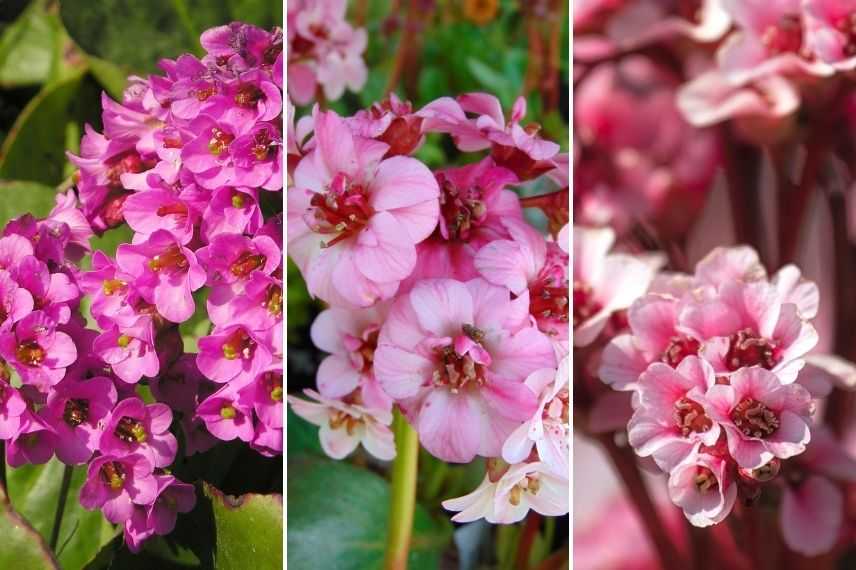
Simple flowers of Bergenia ‘Bartok’ (photo Maja Dumat), double flowers of Bergenia ‘Dragonfly Sakura’, slightly crumpled flowers of Bergenia ‘Eden’s Magic Giant’
Discover other Bergenia
View all →Available in 0 sizes
Available in 2 sizes
Available in 1 sizes
Available in 1 sizes
Available in 2 sizes
Available in 1 sizes
Available in 2 sizes
Available in 1 sizes
Available in 2 sizes
Available in 1 sizes
Choose a bergenia based on fragrance
Bergenias are not the most renowned plants for their fragrance. Most of them are indeed scentless, but there are a few cultivars that are slightly fragrant. This is the case with bergenias ‘Bach’ and ‘Rotblum’.
Choose a bergenia according to the flowering period.
Bergenias flower from late winter in March until the end of spring around mid-June.
Among the earliest varieties, we have ‘Rosenkristall’, which can even show the tips of its petals as early as February, depending on the climate. Also noteworthy are ‘Flirt’, ‘Ouvertüre’ and Bergenia purpurascens, which flower between March and April.
For the later-flowering bergenias, ‘Bressingham White’, ‘Winterglut’ and ‘Spring Fling’ reveal themselves between April-May and June.
Some cultivars also offer a repeat flowering, occurring twice a year, in the case of a cool and humid summer. This is true for ‘Morgenrote’ and ‘Pink Dragonfly’, which first flower between March and April, then between May and July.
Choosing a bergenia based on its foliage
The foliage is one of the other aesthetic assets of bergenia alongside its vibrant flowering. Evergreen, it remains decorative all year round and over time forms beautiful, dense clumps.
The leaves of bergenias are leathery and glossy, sometimes nicknamed “pig’s ears” or “elephant’s ears.” They can vary in size depending on the variety, reaching widths and lengths of 7 to 25 cm. Their shape can also vary: heart-shaped like some Bergenia cordifolia, round like Bergenia crassifolia, or ovate. Their edges are sometimes slightly crinkled, dentate, or undulate.
Different Sizes and Shapes of Leaves
Among the most impressive are ‘Rotblum’ or ‘Bartok’, with leaves that can reach 25 cm long and 20 cm wide, thus forming a true carpet of vegetation. ‘Eden’s Magic Giant’ is no exception, with its impressive crinkled foliage reminiscent of rhubarb.
In contrast, the more discreet ‘Morgenrote’ will fit in anywhere with its small cabbage-like leaves with crinkled edges, not exceeding 15 cm in diameter.
Somewhat different, the Bergenia purpurascens has rather long and narrow leaves.

The giant leaves of Bergenia ‘Rotblum’ (photo J. Hagstrom)
Bergenias with Colourful Autumn Foliage
In terms of colour, the leaves of bergenias range from bright green to dark green. However, some varieties offer changing foliage that is particularly decorative, taking on shades of red in autumn and winter.
This is the case with:
- ‘Flirt’, with its small leaves turning purple to black in the cold;
- ‘Pink Dragonfly’, with its green foliage featuring red veins, which then takes on vibrant plum-red reflections;
- ‘Eden’s Dark Margin’, with dark green leaves edged in purple, turning purple to chestnut in winter;
- ‘Winterglut’, which ignites with a bright and lasting red throughout the cold season;
- ‘Eden’s Magic Giant’, with its incredible purple foliage with metallic reflections, turning red under the influence of the cold;
- ‘Bach’, whose dark green leaves turn red-purple in winter;
- ‘Eroïca’, with large leaves turning bronze-copper;
- ‘Dragonfly Angel Kiss’, with small leaves taking on a red-violet hue during the cold season.

The purple leaves of Bergenia ‘Dragonfly Sakura’
Choosing a bergenia based on its size
Bergenias are small, creeping perennials that are broader than they are tall. They typically reach between 20 and 75 cm in height depending on the variety. This makes them perfect groundcovers.
Bergenias are slow-growing plants, small in size and low-maintenance regarding growing conditions. These plants are therefore ideal for container cultivation. You can easily grow bergenias in flowering pots, window boxes, or troughs to brighten up terraces, balconies, window sills, or small spaces.
For this use, opt for varieties with small foliage and a compact habit, which will be better suited for pot cultivation. For example, this is the case with Bergenia purpurascens (30 cm in all directions), the adorable ‘Baby Doll’ (25 cm tall with a 40 cm spread), ‘Flirt’ (20 cm tall with a 30 cm spread), or ‘Dragonfly Sakura’ (25 cm tall with a 30 cm spread).
On the side of larger varieties, which will easily dress fresh rockeries, shaded borders, or the bases of deciduous shrubs, we can mention ‘Spring Fling’ (70 cm tall with a 30 cm spread) and ‘Eden’s Magic Giant’ (75 cm in all directions at flowering time).
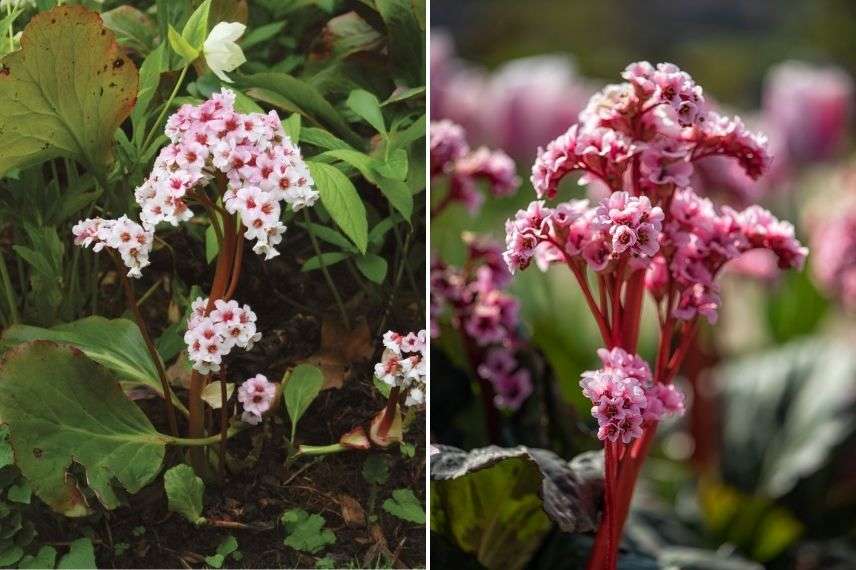
The small Bergenia ‘Baby Doll’ ideal in a pot and to the right the large Bergenia ‘Eden’s Magic Giant’
- Subscribe!
- Contents
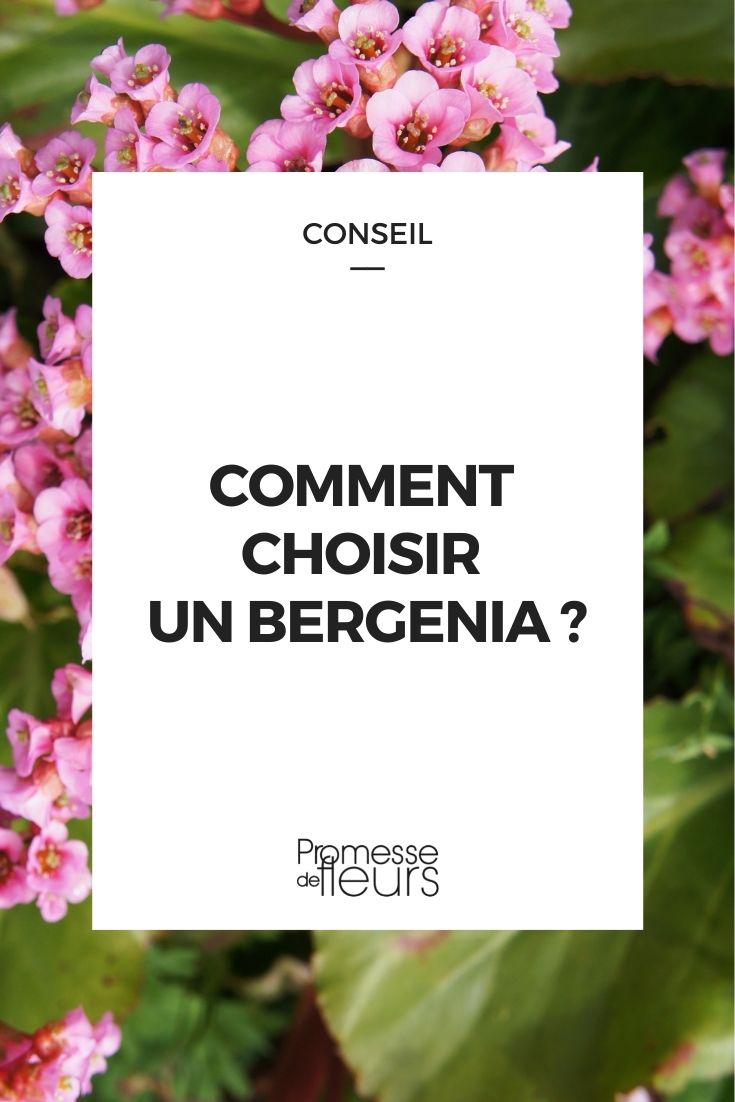































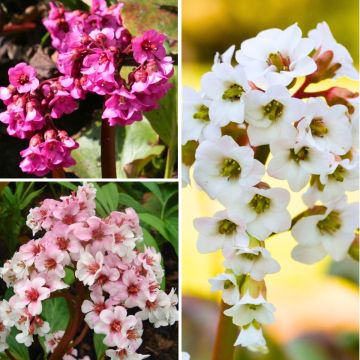
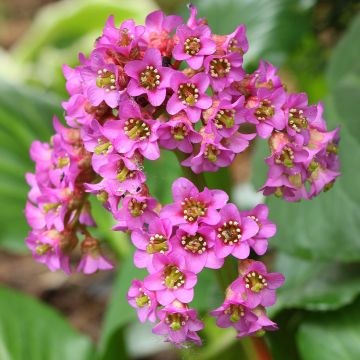
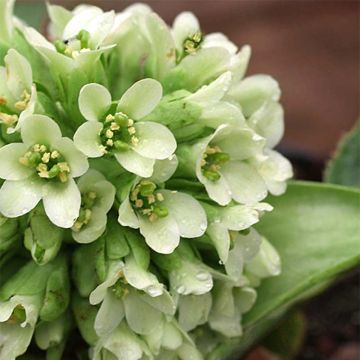
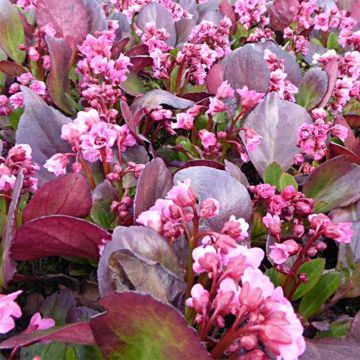
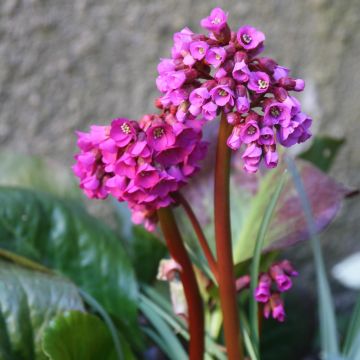
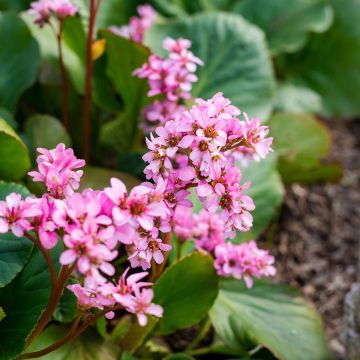


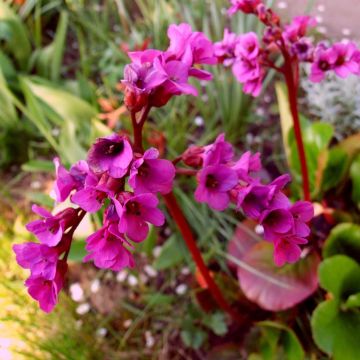

Comments